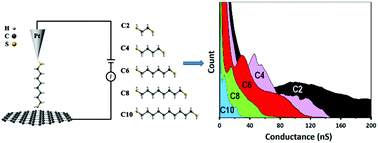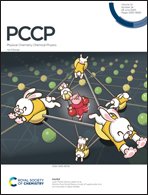Charge transport in hybrid platinum/molecule/graphene single molecule junctions
Abstract
The single molecule conductance of hybrid platinum/alkanedithiol/graphene junctions has been investigated with a focus on understanding the influence of employing two very different contact types. We call this an “anti-symmetric” configuration, with the two different contacts here being platinum and graphene, which respectively provide very different electronic coupling to the alkanedithiol bridge. The conductance of these junctions is experimentally investigated by using a non-contact scanning tunneling microscopy (STM) based method called the I(s) technique. These experimental determinations are supported by density functional theory (DFT) calculations. These alkanedithiol bridging molecules conduct electric current through the highest occupied molecular orbital (HOMO), and junctions formed with Pt/graphene electrode pairs are slightly more conductive than those formed with Au/graphene electrodes which we previously investigated. This is consistent with the lower work function of gold than that of platinum. The measured conductance decays exponentially with the length of the molecular bridge with a low tunneling decay constant, which has a similar value for Pt/graphene and Au/graphene electrode pairs, respectively. These new results underline the importance of the coupling asymmetry between the two electrodes, more than the type of the metal electrode itself. Importantly, the tunneling decay constant is much lower than that of alkanedithiols with the symmetrical equivalent, i.e. identical metal electrodes. We attribute this difference to the relatively weak van der Waals coupling at the graphene interface and the strong bond dipole at the Pt–S interface, resulting in a decrease in the potential barrier at the interface.

- This article is part of the themed collection: 2020 PCCP HOT Articles


 Please wait while we load your content...
Please wait while we load your content...